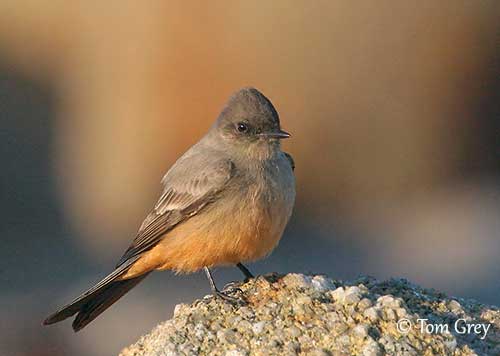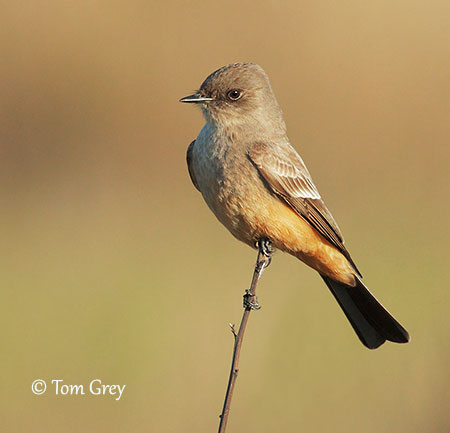
Fr: Moucherolle à ventre roux
Ang: Say’s Phoebe
All: Zimtbauch-Phoebetyrann
Esp: Mosquero Llanero
Ita: Fibi di Say
Nd: Says Phoebe
Sd: rödbrun fibi
Photographer:
Tom Grey
Tom Grey's Bird Pictures & Tom Grey's Bird Pictures 2
Text by Nicole Bouglouan
Sources:
HANDBOOK OF THE BIRDS OF THE WORLD Vol 9 - by Josep del Hoyo - Andrew Elliot - David Christie - Lynx Edicions - ISBN: 8487334695
BIRDS OF THE GREAT BASIN – by Fred A. Ryser - Univ of Nevada Pr -ISBN: 0874170796
FIELD GUIDE TO THE BIRDS OF NORTH AMERICA by National Geographic Society - National Geographic Society - ISBN: 0792274512
All About Birds (Cornell Lab of Ornithology)
The Birds of North America online
Audubon
What Bird-The ultimate Bird Guide (Mitchell Waite)
Bird Web (Seattle Audubon Society)
Wikipedia, the free encyclopaedia
Say’s Phoebe
Sayornis saya
Passeriformes Order – Tyrannidae Family
INTRODUCTION:
The Say’s Phoebe is a member of the family Tyrannidae. This species occurs in North America from C Alaska to NW Mexico. It frequents dry, open country, canyons and cliffs. It feeds on insects typically caught by sallying from perches.
The pair forms on the breeding territories, following displays by males accompanied by songs. The cup-shaped nest is often built on cliff ledges, hollows or caves, but this species may also use human-made structures.
The Say’s Phoebe is described as common to fairly common. Degradation of the habitat caused by change in agricultural practices and increasing urbanisation may affect this species in the future, but currently, it is not globally threatened.
The Say’s Phoebe was named after Thomas Say, an American naturalist who was the first scientist to find the bird in 1819 in Colorado.

DESCRIPTION OF THE BIRD:
Biometrics:
Length: 17-19 cm
Weight: 21-22 gr
The Say’s Phoebe has pale greyish-brown upperparts with darker head, wings and tail. The upperwing shows pale brown-grey margins on wing-coverts and flight-feathers, the latter being almost translucent in flight. The tail is mostly brownish-black.
On the underparts, throat and breast are pale greyish-brown, but paler than the upperparts. Belly, flanks and undertail-coverts are cinnamon.
On the brown-grey head, the forehead is slightly paler, whereas crown and nape are mostly darker grey. The lores may appear blackish.
Bill, legs and feet are black. The eyes are dark brown.
Male and female are similar.
The juvenile is browner above, and two cinnamon wingbars are formed by the tips of both median and greater coverts.
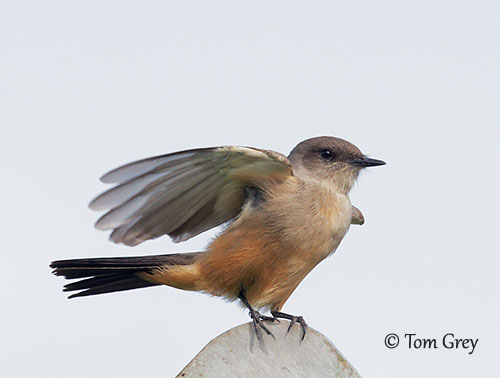
SUBSPECIES AND RANGE:
The Say’s Phoebe has two subspecies.
S.s. saya (described above) breeds in N Alaska, S through W Canada and W and WC USA to C Mexico. It winters from S USA (California E to Texas) S to C and S Mexico.
S.s. quiescens is found in NW Mexico (N Baja California and Cedros Island).
This race is paler grey and less brown than nominate. The throat is white and there is a narrow, grey breastband. The bill is larger and wider.
HABITAT:
The Say’s Phoebe is found in open areas in valleys and foothills, often in dry areas, farmland, savannahs or prairies in south, and mainly in dry upland tundra in north. It usually avoids the forested areas, preferring sparsely wooded places with low, scattered shrubs. This species is known for nesting in residential areas.
CALLS AND SONGS: SOUNDS BY XENO-CANTO
The typical call of the Say’s Phoebe is a thin, plaintive “pee-ee” slightly downslurred.
The song is described as a fast “pit-tse-ar” often given while the bird performs fluttering flight. This species may also perform bill-snapping during aggressive encounters.
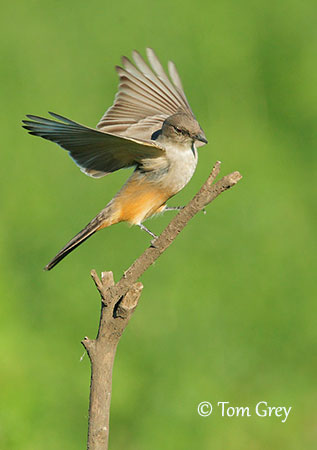
BEHAVIOUR IN THE WILD:
The Say’s Phoebe feeds primarily on insects such as bees, wasps, winged ants, beetles, moths, grasshoppers, crickets and dragonflies. It also takes spiders and millipedes, and may occasionally consume berries.
It catches the prey close to the ground and even sometimes on the ground. It forages actively in low, sparse vegetation, usually perched on weed tips, low bushes, rocks, fence posts and wires.
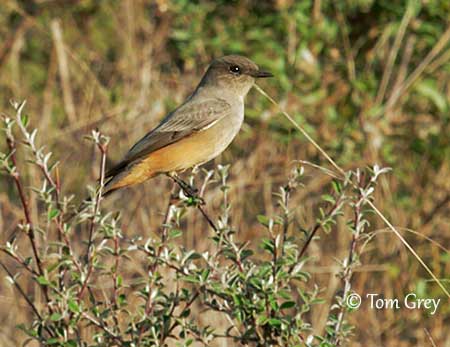
It often hovers low over the ground while searching for prey. Once the prey is located, the bird drops on to the ground and captures it. It also performs aerial sallies with short, direct flight from perch, but it does not engage in the pursuit of a flying insect. It also gleans prey from the vegetation or the ground.
This species is not observed drinking but it obtains sufficient water from the arthropods.
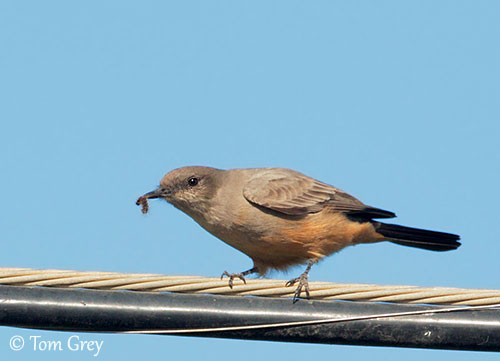
The Say’s Phoebe is mostly solitary outside breeding season. The male arrives first and the pair forms soon after the females arrive. They are monogamous during the breeding season.
The male usually visits several nest-sites. It displays for the female, fluttering in arcs but also hovering above the site while singing. It sings from exposed perch or in flight to defend the territory.
The nest is an open cup made with plant material, but this species does not use mud in nest-building like the two other phoebes of genus Sayornis, the Black Phoebe and the Eastern Phoebe. The nest-site may be reused year after year.
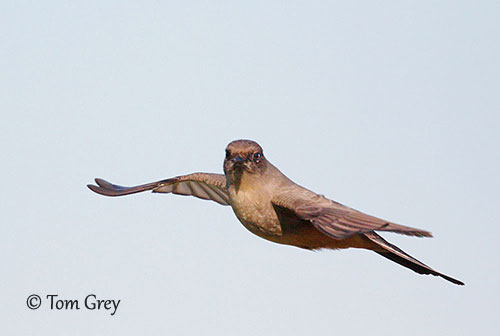
The Say’s Phoebe is migratory, but the species is also present all year round in most part of SW USA and Mexico. The northern populations leave the breeding grounds from late August to mid-September (late October in Texas). The species winters in November-March and returns to the breeding areas where it arrives from mid-February to mid-March, depending on the range.
The Say’s Phoebe performs buoyant fluttering flight with shallow wingbeats. It hovers while hunting for insects.
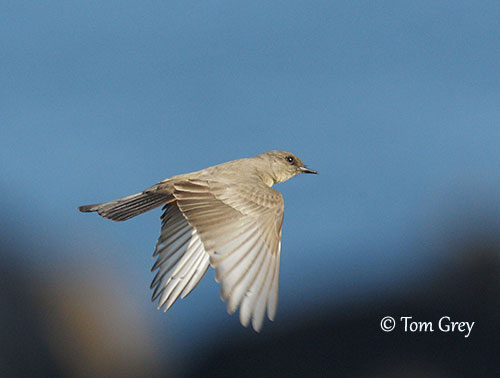
REPRODUCTION OF THIS SPECIES:
The breeding season takes place from mid-April to early August in USA and Canada, and March-September in Mexico. This species often produces two broods per season, sometimes three in the southern part of the range.
The nest-site may vary and this species usually prefers sites with solid overhead cover. The nest can be found on rocky ledges or in crevices in cliff, on ledges in caves, beneath overhanging rocks on cliff sides or holes in banks. But this species may also nest on artificial structures including bridges, abandoned mines, buildings and even porches.
The nest is probably built by the female. It is a flat, open, cup-shaped structure made of grass, weeds, moss, spider webs, wools, but this species does not use mud. The cup is lined with hair, wool and feathers.
The female lays 3-7 (usually 4) white eggs with small dark spots. She incubates alone during 12-14 days. The chicks are fed by both parents with insects. They fledge 14-16 days after hatching, and usually disperse three days later and leave the nest area.
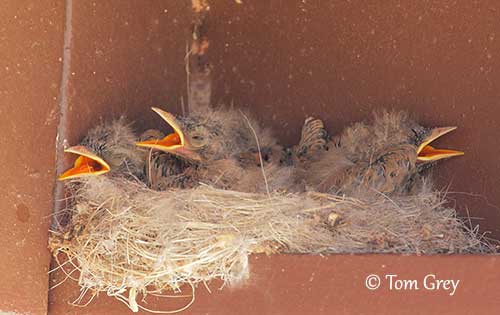
PROTECTION / THREATS / STATUS:
The Say’s Phoebe is usually common to fairly common throughout the range. This species is able to adapt to changes in the habitat and often nests in residential areas. However, change in agricultural practices and increase of urbanisation may affect this species in the future.
The global population is estimated to number 3,700,000 individuals and it is suspected to be increasing, especially in Canada.
The Say’s Phoebe is not globally threatened and currently evaluated as Least Concern.
